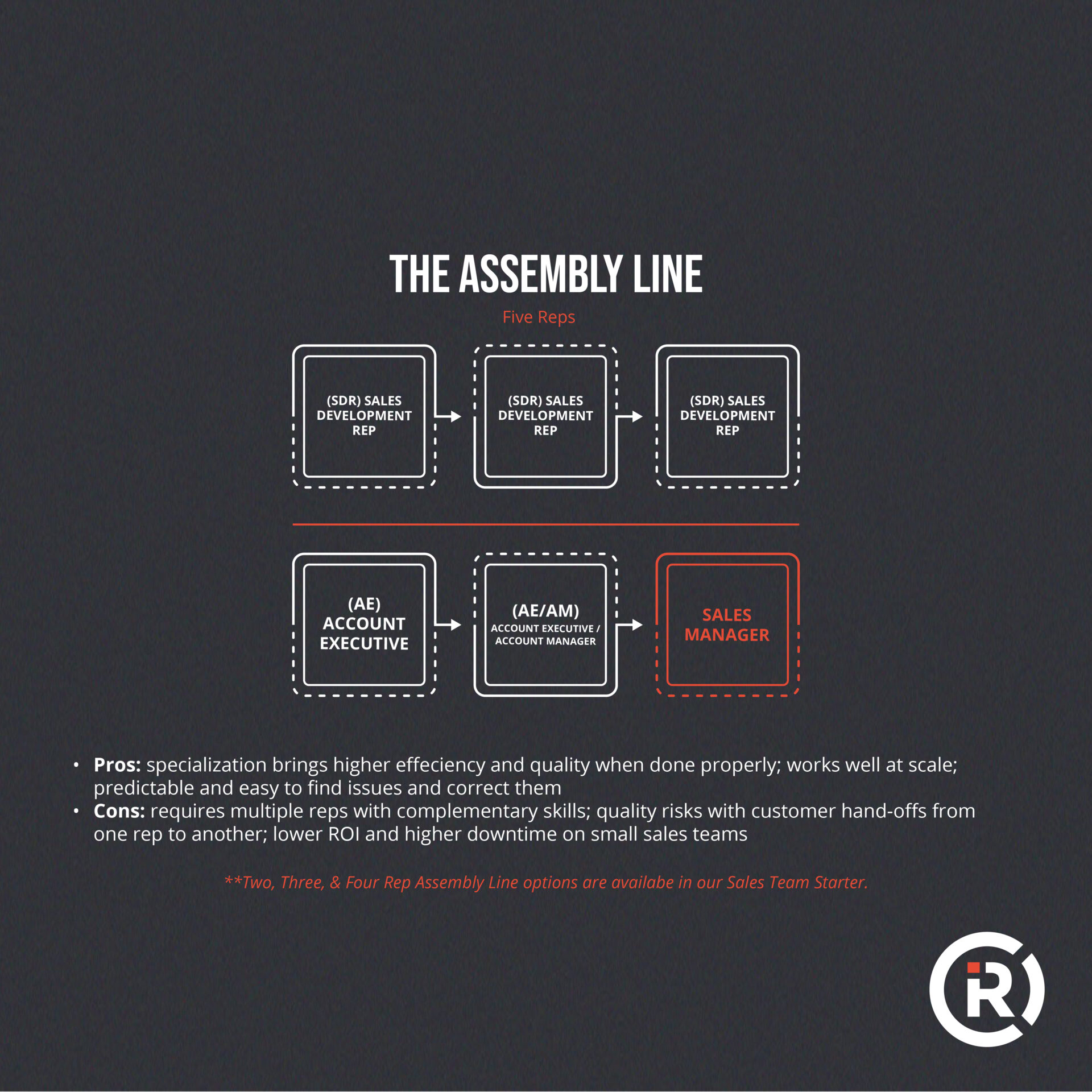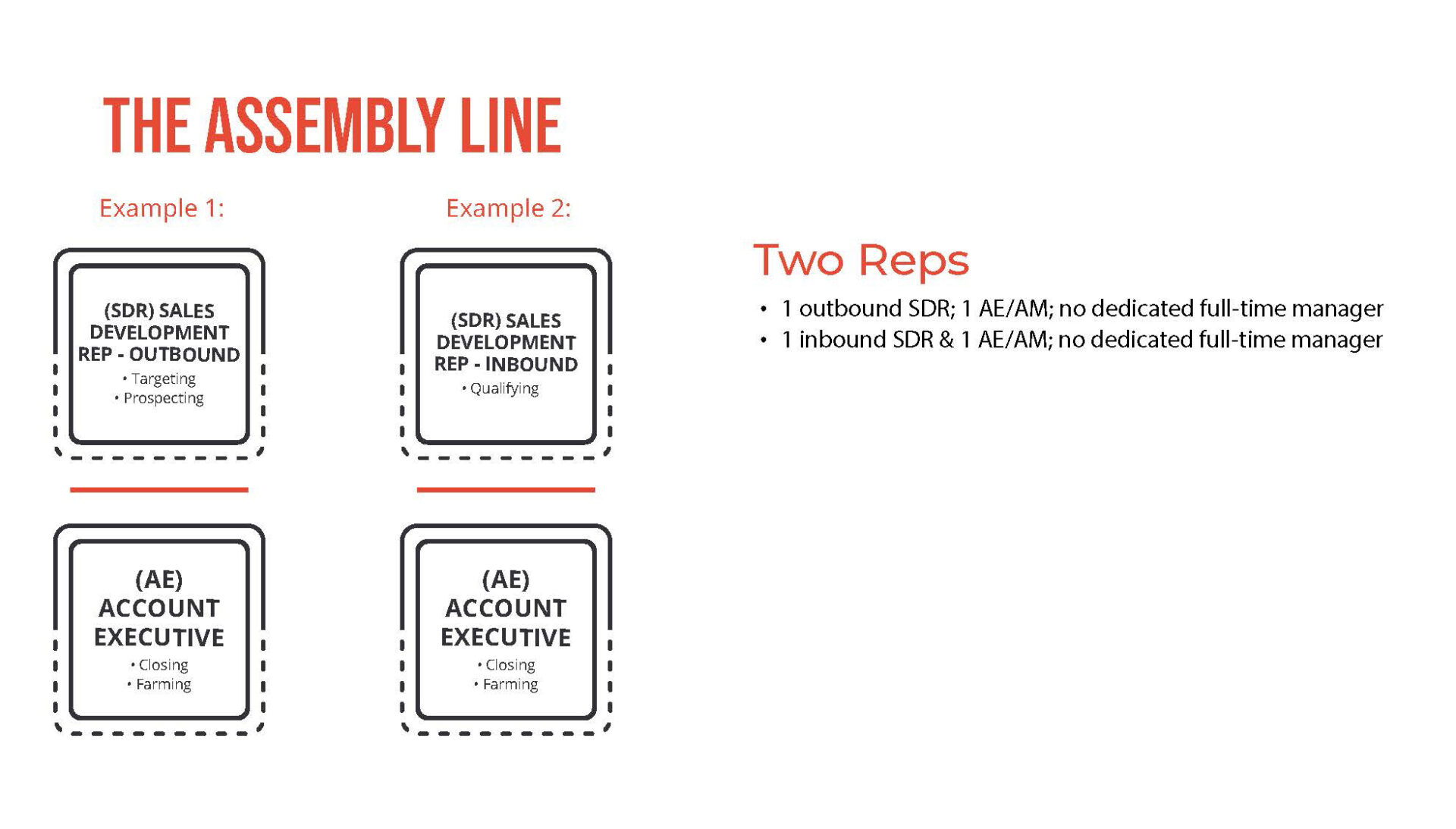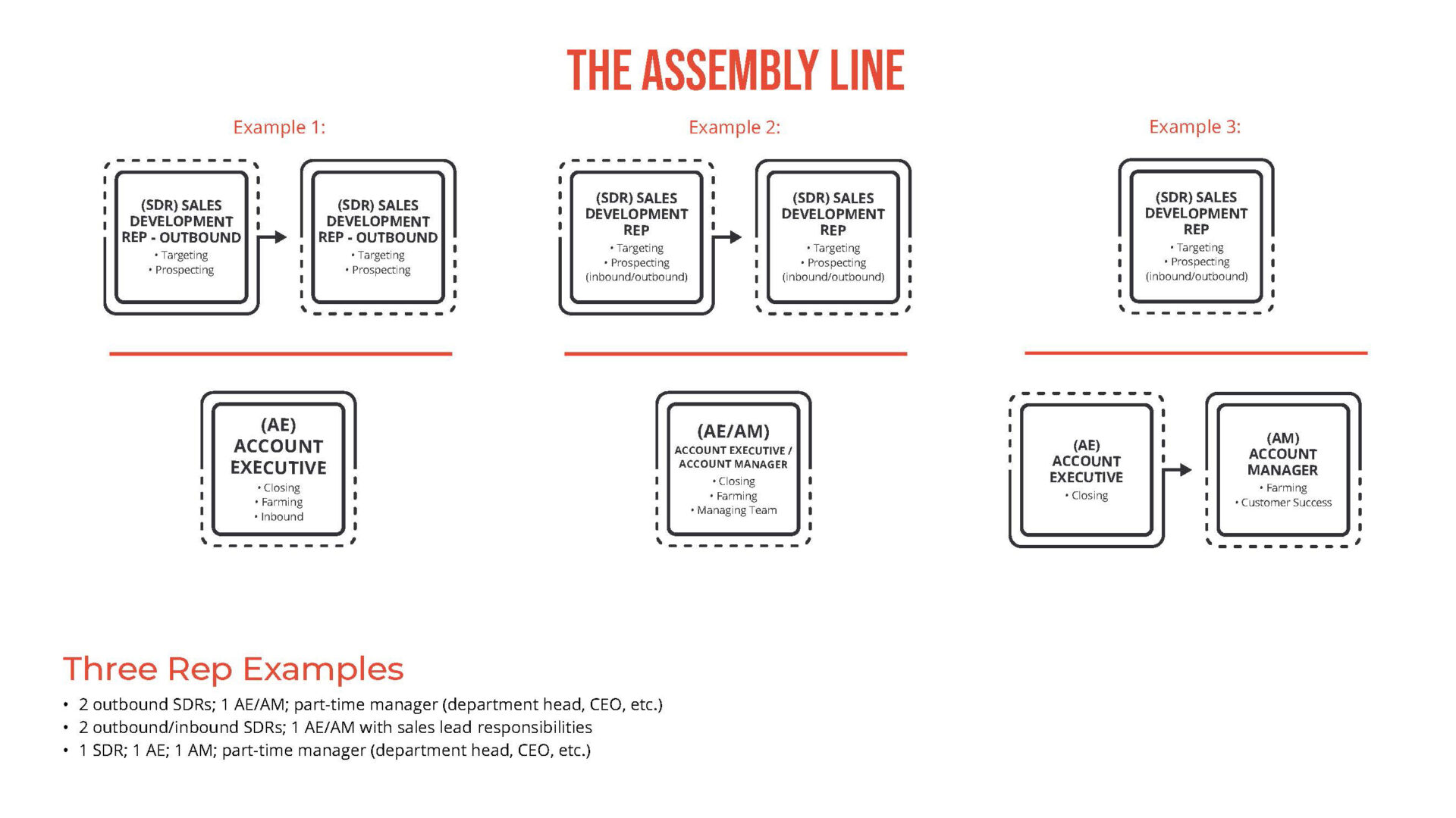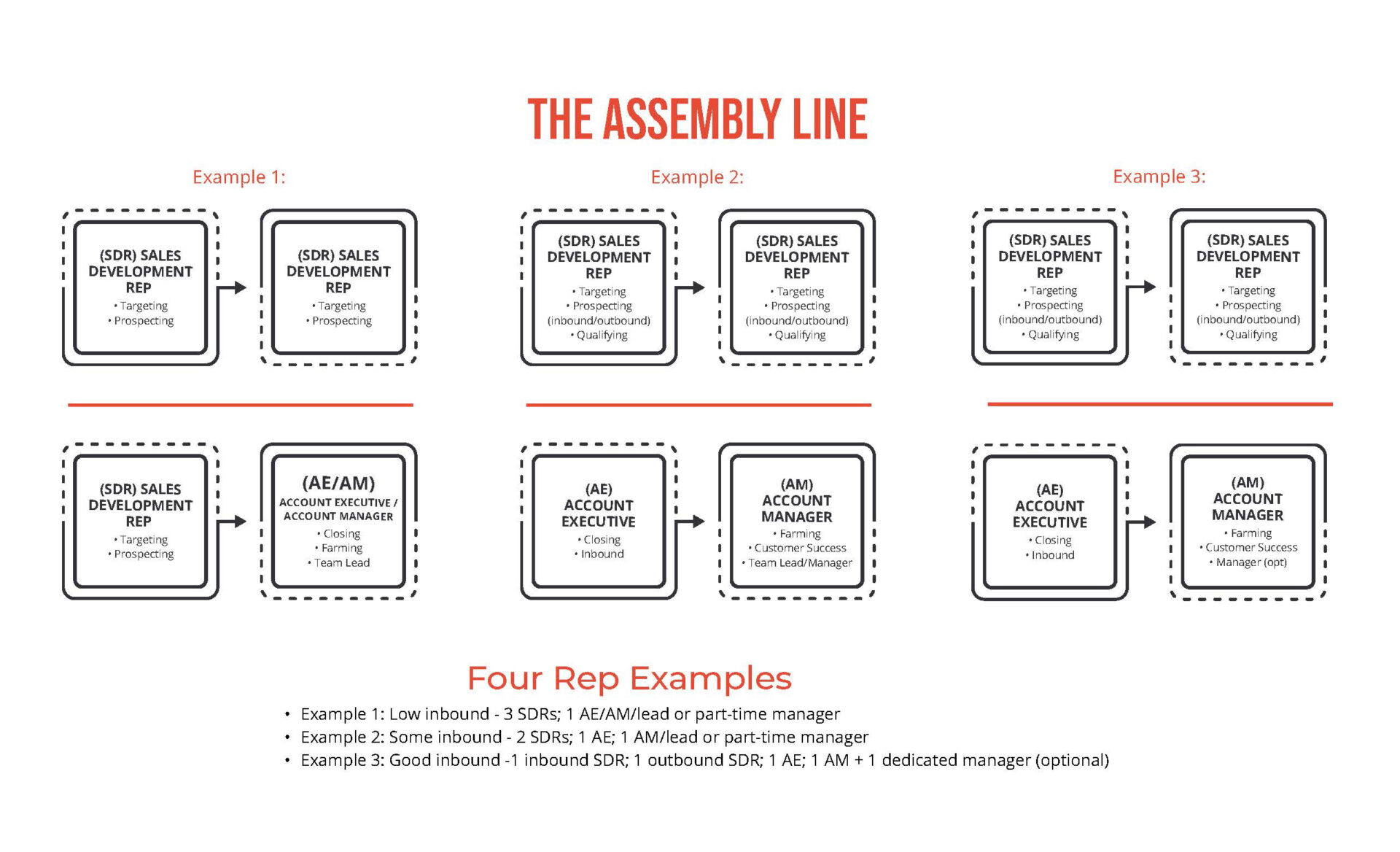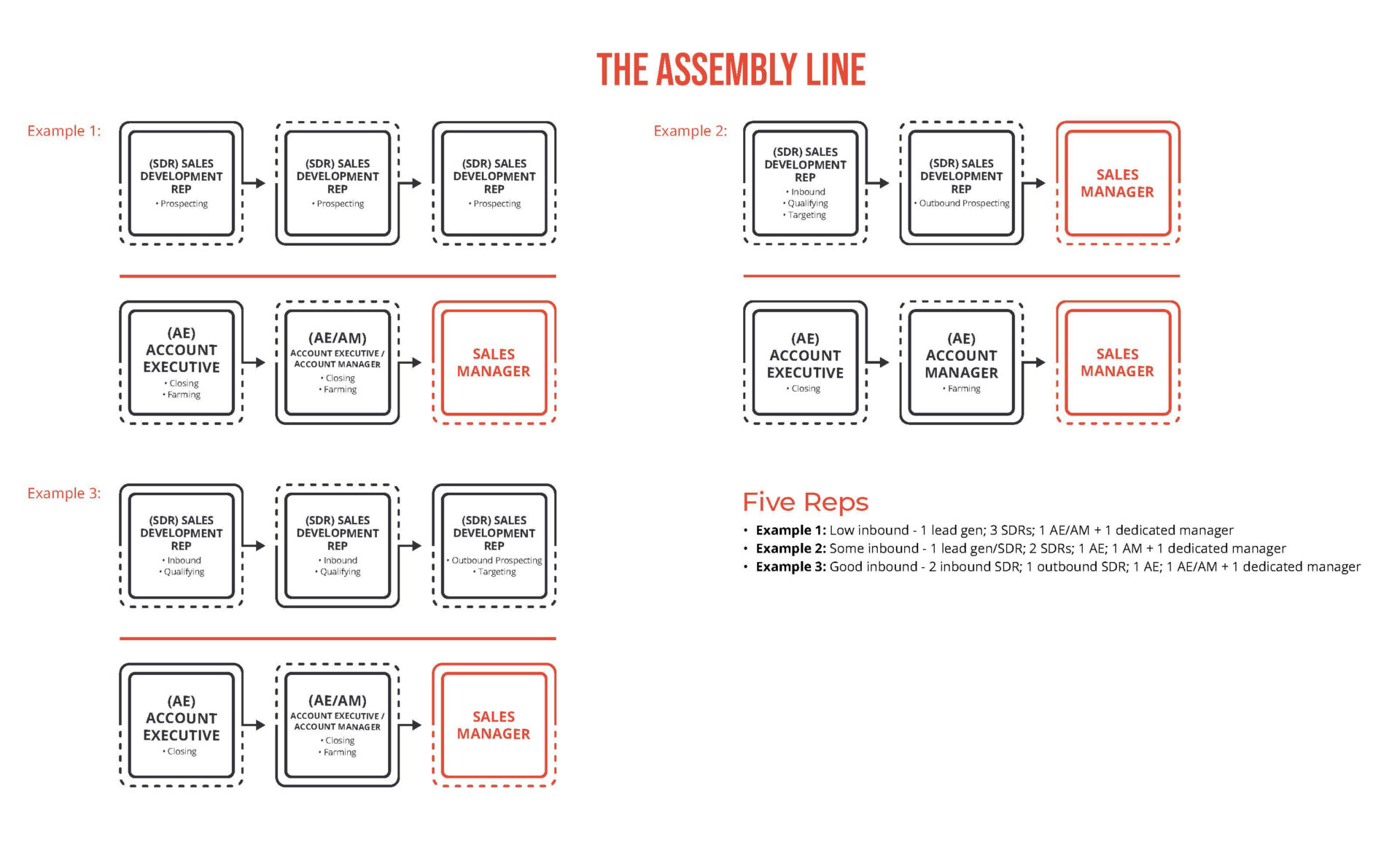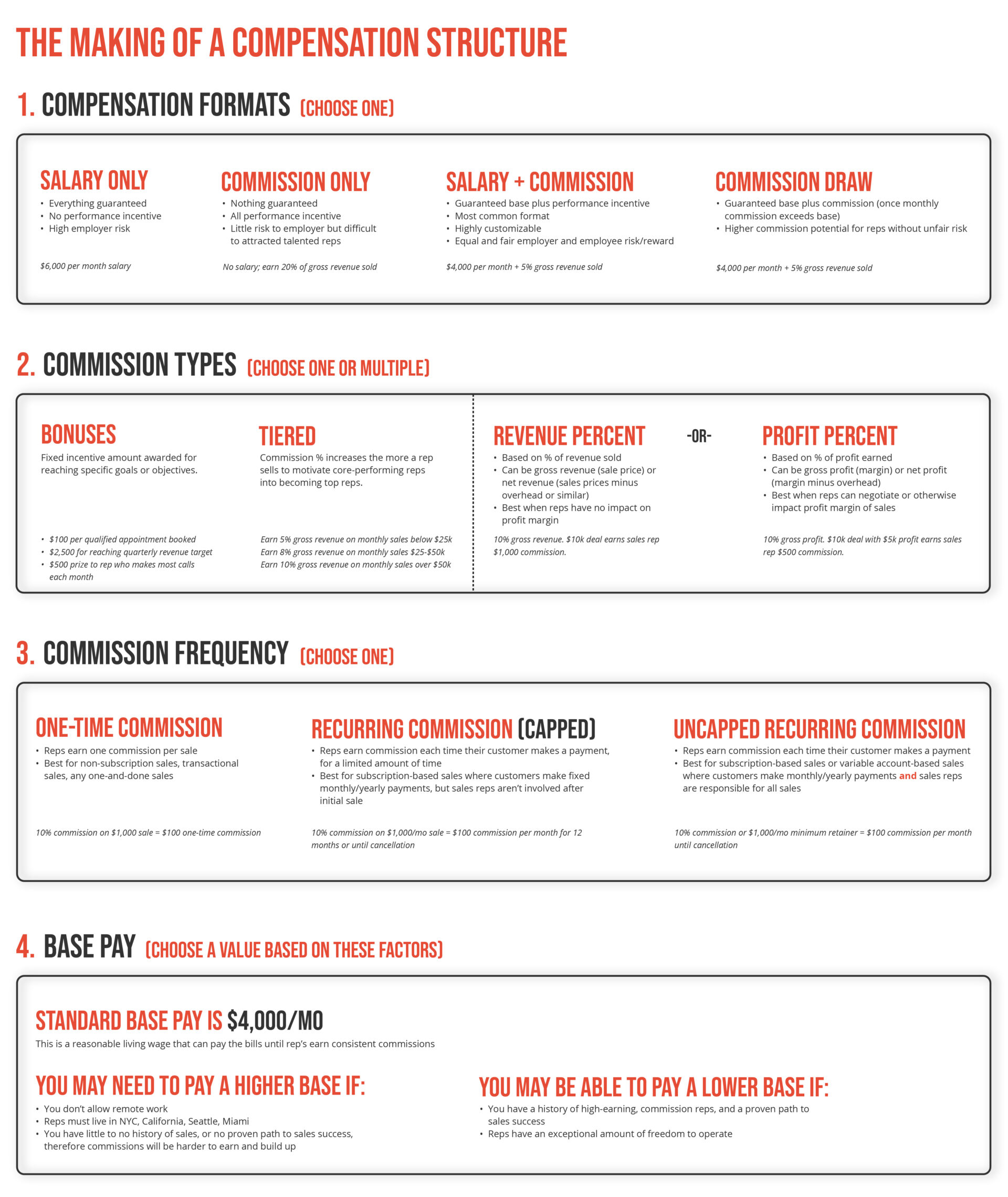Selecting the right structure for your sales team is an important decision with a lot of downstream impacts. The one that is right for you ultimately depends on your organizational structure, sales goals, and needs. Making the right choice can give you a competitive edge. If you are struggling to make sense of the options, we have you covered.
The three most popular structures are the “Assembly Line,” “Island,” and “Pod.” The table below provides a high-level comparison of the different types of sales structures. Read on for the in-depth analysis of each, along with the corresponding strategies, benefits, and challenges.
| Structure Name | Benefits | Challenges |
| The Assembly Line This sales team structure emphasizes specialization in different roles at each stage of the sales process. It enhances efficiency and scalability but also presents potential challenges in cost, quality, and turnover. |
|
|
| The Island This sales team structure emphasizes individual responsibility. Each sales representative manages the entire sales process. This ensures a single point of contact for customers and fosters a competitive yet self-reliant environment. |
|
|
| The Pod This hybrid sales structure blends the Island and Assembly Line models. A team of specialists manages accounts through the entire customer lifecycle. It emphasizes a customer-centric sales strategy. Each pod focuses on specific niches, geographies, or verticals, ensuring specialization and expertise. |
|
|
Whichever sales model or sales organization structure your team uses, whether geographical, product or service line, industry or vertical, or account-based selling, one of these sales team structures will be right for your sales force.
The materials, templates, and examples in our Sales Team Starter will guide you through the building process and help ensure you construct an effective team.
Assembly Line
The Assembly Line sales team structure emphasizes specialization at each stage of the sales process. Teams are made up of reps who specialize in only that stage of the sales cycle. Since every team member specializes in the same stage, they are able to provide backup to one another to cover vacations and lunch breaks, for example.
As accounts progress through the sales process, they move from specialized team to specialized team within your sales department. Reps have no further contact with the customer once the account moves to the next stage of the sales process.
This structure is efficient and scalable but may cost more for small businesses and startups with smaller teams, decrease quality, and increase turnover.
Key Components:
- Lead Generation Reps: Identify and compile contact information of potential leads.
- Sales Development Reps (SDRs): Qualify leads and schedule appointments.
- Account Executives (AEs): Meet qualified leads and close deals.
- Account Managers (AMs) & Customer Success Managers (CSMs): Ensure customer success post-sale. They also focus on upselling and enhancing customer lifetime value.
Benefits:
- Efficiency: Specialized roles with specific job titles allow sales professionals to develop skills quickly and work more proficiently.
- Process improvements: Reps identify and correct issues efficiently in their area of expertise.
- Scalability: Adaptable to various company sizes.
- Predictability: Facilitates reliable revenue forecasting due to consistent conversion rates at each stage.
Challenges:
- Cost: Initial expenses may be higher since you need at least one of each specialized rep for coverage, even though you may not need 100% of each rep’s total capacity.
- Quality Risks: Poor handoffs between teams may compromise customer experience.
- Turnover: Particularly in lower-skill roles, which might not offer competitive pay.
Tips for Designing an Assembly Line Model:
How you structure your assembly line will depend on your inbound lead volume and the level of experience of your SDRs:
- If you have a substantial number of inbound leads, SDRs should focus on qualifying leads to free up your AE’s time to spend with prospects.
- If you have limited inbound leads, SDRs should focus on outbound prospecting and appointment setting.
- Highly skilled or experienced SDRs can potentially lead introductory calls without an AE present if volume demands it.
- Inexperienced SDRs should focus only on setting appointments and handing them off to the AE. This allows both the SDR and AE to focus on their core competencies.
Metrics to Track:
Lead Generation:
| Metric | Description | Example Quota |
| Lead-to-conversion | The percentage of targeted leads who achieve a primary prospecting goal | 5% of targeted leads schedule a demo |
| Lead-to-qualified | The percentage of targeted leads who become sales qualified leads (SQLs) | 2% of targeted leads become SQLs |
| Lead-to-close | The percentage of targeted leads who become customers | 1% of targeted leads become customers |
| Lead revenue | Revenue generated by targeted leads within a set time period | $10,000 revenue from targeted leads per month |
| Leads targeted | The number of leads targeted within a set time period | 1,000 new outbound leads targeted per month |
Outbound SDRs
| Metric | Description | Example Quota |
| Calls attempted | The number of phone calls attempted (dialed) | 65 outbound calls per day |
| Touch points | The number of calls + emails + meetings | 105 total touch points per day |
| Records touched | The number of unique prospects (accounts) engaged | 55 unique records updated in the CRM per day |
| On-time task completion | The percentage of due follow-up tasks remaining in the CRM | No more than 5% incomplete follow-up tasks remaining at the end of each day |
| Meetings booked | The number of meetings booked | 15 meetings booked per month |
| Meetings held | The percentage of meetings attended | No more than 10% of meetings are no-show or canceled |
| Prospected revenue | Revenue of leads prospected by one rep and closed by a second rep | $10,000 revenue from prospected leads per month |
Inbound SDRs
| Metric | Description | Example Quota |
| Qualified-to-close | The percentage of leads qualified by one rep and closed by a second rep | 40% of qualified leads result in closed won |
| Calls answered | The percentage of inbound phone calls answered | 90% of calls answered during business hours |
| Response time | How quickly reps respond to inbound sales emails | Respond to emails within 1 hour |
| On-time task completion | The percentage of due follow-up tasks remaining in the CRM | No more than 5% incomplete follow-up tasks remaining at the end of each day |
| Prospected revenue | Revenue of leads prospected by one rep and closed by a second rep | $10,000 revenue from prospected leads per month |
AEs
| Metric | Description | Example Quota |
| Touch points | The number of calls + emails + meetings | 105 total touch points per day |
| Records touched | The number of unique prospects (accounts) engaged | 55 unique records updated in the CRM per day |
| On-time task completion | The percentage of due follow-up tasks remaining in the CRM | No more than 5% incomplete follow-up tasks remaining at the end of each day |
| Opportunity-to-close | The percentage of sales qualified opportunities (SQOs) that become customers | 30% of SQOs become customers |
| Proposal-to-close | The percentage of sent proposals that result in closed opportunities | 65% of proposals result in customers |
| Opportunity duration | The average cycle from opportunity creation to close | Average sales cycle of 25 days or less |
| Closed opportunities | Number of new customers | 10 new customers per month |
| Closed revenue | Revenue from closed opportunities | $10,000 revenue closed per month |
AMs/CSMs
| Metric | Description | Example Quota |
| Maintain churn | Tracks how well reps are keeping current customers happy and buying | No more than 5% churn in any quarter |
| Revenue from upsells | The total amount of revenue earned from upselling current accounts | $5,000 in upsell revenue per quarter |
| Average account growth | Tracks the average amount each account grows | Grow each account’s revenue by 10% per year |
| Accounts met with | Tracks the percentage of assigned accounts met with | Meet with 95% of accounts every month |
| Accounts sold to | Tracks the percentage of assigned accounts sold to | Sell to 80% of assigned accounts every month |
| On-time task completion | The percentage of due follow-up tasks remaining in the CRM | No more than 5% incomplete follow-up tasks remaining at the end of each day |
Compensation:
Compensation can be structured in many different ways, and we’ll include a graphic later in this article breaking down the different steps toward creating a compensation plan.
Most compensation plans in the Assembly Line include a base salary + percent commissions for outcomes such as revenue or profit + fixed bonuses for effort such as booked meetings or quota attainment.
| Lead Generation Reps | SDRs | AEs | AMs/CSMs |
Before hiring a full-time employee, consider:
|
|
|
|
How To Build the Assembly Line Structure
Identify the distinct stages of your sales process, such as lead generation, qualification, product demonstration, negotiation, and deal closure.
Assign sales reps to handle each stage of the customer journey, ensuring efficiency and expertise throughout the sales process. This structure is highly efficient for organizations with a high volume of leads and a complex sales process.
For example, you may have sales reps dedicated to lead generation, responsible for prospecting and qualifying leads. Qualifying means prioritizing sales effort on leads that are likely to close and earn high revenue.
Establish clear procedures for transferring leads from one stage to another, ensuring seamless transitions and continuity throughout the sales process. Define criteria for lead qualification and handover criteria to ensure that leads are passed onto the next stage only when they’re ready.
Streamline end-to-end communication and collaboration among sales reps. This will facilitate efficiency and coherence throughout the entire sales journey. Sales tools such as CRMs, project management platforms, and communication apps can greatly enhance this critical element of your sales team.
CRM stands for customer relationship management, and CRM software allows your sales team to collaborate and manage everything sales-related in one place – adding consistency to the customer journey as they move through the stages of the Assembly Line. CRMs track the sales process, prospecting, customer lifecycle, KPIs, commissions, conversations, website traffic, and more.
A CRM like ActiveCampaign is well-suited for marketing-heavy strategies, Close is a good fit for a sales-only strategy, and HubSpot is effective in a sales methodology that blends marketing and sales approaches.
Continuously review and optimize each stage of the sales process to enhance efficiency, identify bottlenecks, and improve overall performance. Collect feedback from sales teams, analyze performance metrics, and iterate on your sales process to adapt to changing market conditions and customer needs.
Here’s a breakdown of how to structure your Assembly Line model, depending on how many sales reps you have. You can scroll through the slides below:
The Island
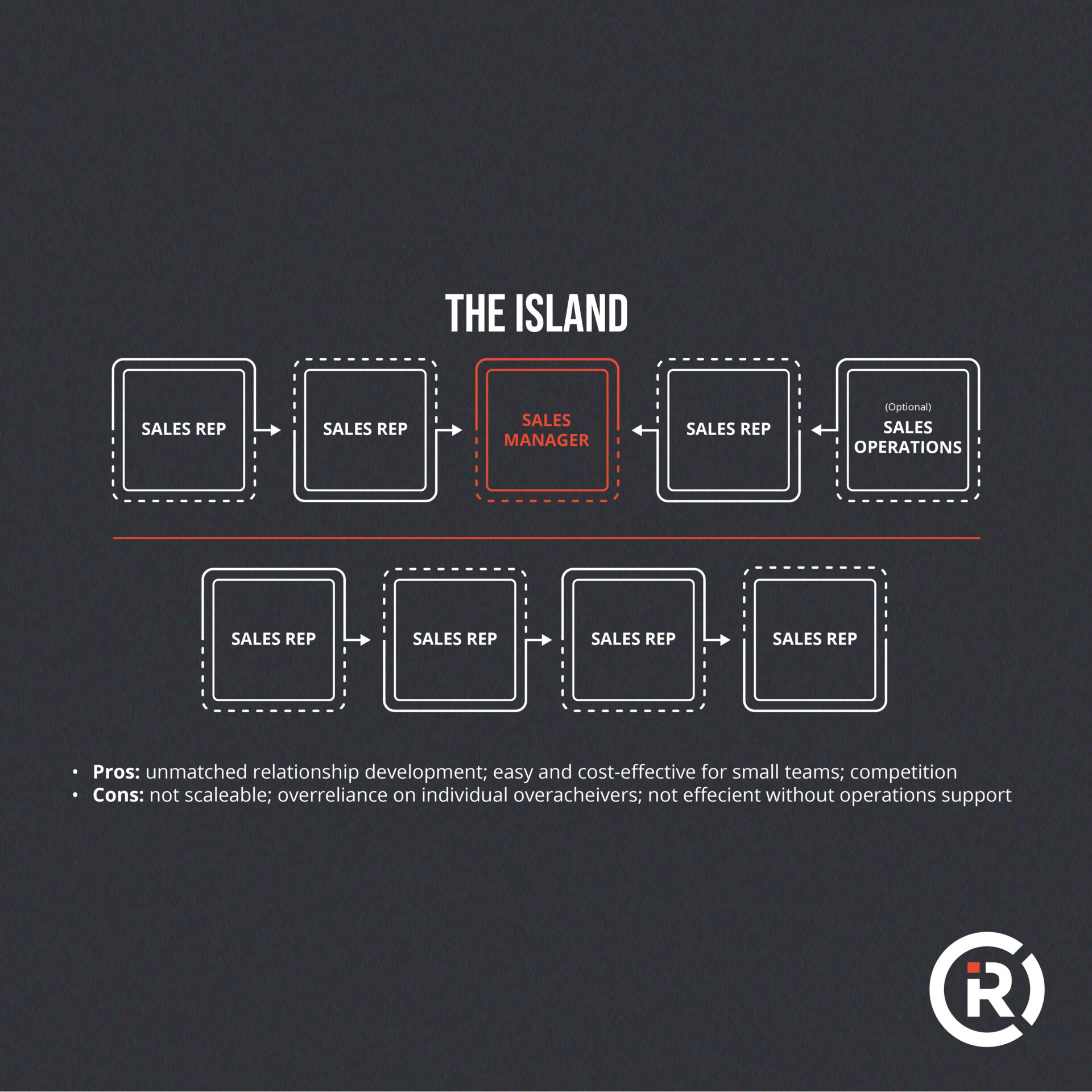
The Island model emphasizes individual responsibility and competition among sales reps. Each rep manages the entire sales process for their customers, from lead generation to close, and essentially competes with every other rep on their team. It is a straightforward and initially cost-effective approach to managing the sales process.
Operational simplicity and customer relationship quality are clear benefits of this model. Challenges include scalability and potentially negative behavior resulting from the competitive nature of the structure. Effective design and account management rules of engagement are crucial to navigate these challenges, streamline the sales process, and optimize the model.
Key Components:
- Competition: Reps essentially compete with each other for customers.
- Self-Reliance: Reps generate leads and manage engagement, qualification, and closure independently.
- Cost-Effective: Requires fewer reps initially.
- Simplicity: Allows reps to manage their sales processes autonomously.
Benefits:
- Cost: More can be done with fewer reps, especially in the early stages.
- Quality: A single point of contact for customers fosters customer loyalty.
- Competition: Competition among reps can boost team output.
Challenges:
- Reliance on Reps: Over-dependence on high-performing reps can be risky if their sales performance declines or they leave.
- Scalability Issues: As the team grows, maintaining quality and efficient communication becomes challenging.
- Inadequate Outbound Prospecting: Reps may neglect outbound prospecting due to its demanding nature.
Tips for Designing an Island Model:
- A sales manager for every 4-6 reps is important in this model to ensure each rep is appropriately managing every aspect of the process for each customer.
- Ensure quotas for outbound prospecting are set and enforced. For additional assistance with quotas, download our free quota calculator.
- Invest in operational efficiency by hiring a dedicated sales operations rep or using properly configured sales technology with workflow automations. This is especially important if the sales process involves many administrative tasks.
- Ensure sales processes are documented and adhered to. If you haven’t documented your sales processes, check out this blog to get you started.
Metrics to Track:
| Metric | Description | Example Quota |
| Lead-to-close | The percentage of targeted leads who become customers | 1% of targeted leads become customers |
| Calls attempted | The number of phone calls attempted (dialed) | 65 outbound calls per day |
| Touch points | The number of calls + emails + meetings | 105 total touch points per day |
| Records touched | The number of unique prospects (accounts) engaged | 55 unique records updated in the CRM per day |
| Meetings held | The percentage of meetings that are attended | No more than 10% of meetings are no-show or canceled |
| On-time task completion | The percentage of due follow up tasks remaining in the CRM | No more than 5% incomplete follow up tasks remaining at the end of each day |
| Opportunity-to-close | The percentage of sales qualified opportunities (SQOs) that become customers | 30% of SQOs become customers |
| Proposal-to-close | The percentage of sent proposals that result in closed opportunities | 65% of proposals result in customers |
| Opportunity duration | The average cycle from opportunity creation to close | Average sales cycle of 25 days or less |
| Closed opportunities | Number of new customers | 10 new customers per month |
| Closed revenue | Revenue from closed opportunities | $10,000 revenue closed per month |
| Revenue from upsells | The total amount of revenue earned from upselling current accounts | $5,000 in upsell revenue per quarter |
| Average account growth | Tracks the average amount each account grows | Grow each account’s revenue by 10% per year |
| Accounts met with | Tracks the percentage of assigned accounts met with | Meet with 95% of accounts every month |
| Accounts sold to | Tracks the percentage of assigned accounts sold to | Sell to 80% of assigned accounts every month |
Compensation:
Reps should be compensated based on individual performance through commissions and bonuses, in addition to their base salary.
There is only one type of sales representative in an Island structure since reps handle both prospecting and closing. Here’s a complete breakdown of compensation structures for your salespeople:
How To Build the Island Structure
Define the islands by dividing your target market into manageable territories based on geographical location or industry sector. This decentralized approach is particularly suitable for small teams or businesses with a limited product or service range, but it’s essential to ensure each salesperson has a clearly defined area to focus on to avoid overlap or confusion.
Establish a sales process. Sales representatives should be given full responsibility for their territory, from prospecting to closing deals. Prospecting is the process of engaging potential customers or leads.
Setting up the initial sales process gives your team a framework to get started. They should have a deep understanding of their territory’s dynamics, customer needs, and competitive landscape.
Track individual sales performance metrics such as lead conversion rates, deal closure rates, and customer satisfaction scores. Analyzing this data helps identify areas of strength and weakness, allowing for targeted coaching and support where needed. Additionally, performance monitoring enables the organization to adjust strategies and allocate resources effectively.
Offer support. While independence is a cornerstone of the Island structure, it’s crucial to provide a support system for sales representatives. This support can include training programs and access to resources such as marketing materials or CRMs.
The Pod

The Pod is a hybrid sales structure. It combines elements of the Island and Assembly Line. A single pod will manage accounts from lead generation to close. However, within the pod there are specialists for each stage of the sales process, and customers move to a new specialist with each stage.
Key Components:
- Customer-Centric Strategy: Pods focus on customer support. These can focus on specific niches, geographies, or verticals. Pods ensure specialization and expertise in handling accounts. Examples include:
- Accounting agencies operating in different states
- Law firms selling to various verticals
- Logistics companies grouping customers by freight type
- Marketing agencies grouping customers by target demographics and content types
Benefits:
- Quality Control: Since the pod is responsible for the end-to-end customer experience, the whole team is incentivized to produce the highest possible quality from end to end.
- Agility: Ability to focus on specific verticals or geographies.
- Predictability: Consistency and predictability in sales forecasts and KPIs.
Challenges:
- Rep Motivation: Ensuring each rep contributes effectively can be challenging. Disparities in performance can lead to internal team issues.
- Performance: Varied performance levels within the pod structure can create tension and impact overall success.
- Turnover: Frequent changes in rep assignments can disrupt customer relationships and team dynamics.
Tips for Designing a Pod Model:
- If most revenue comes post-initial sale, create more AM/CSM roles.
- If most revenue comes during the initial sale, create more SDR roles and invest in AE training.
- If leads are primarily inbound, consider combining SDR and AE roles.
- If leads are primarily outbound, keep SDR roles separate and possibly have two SDRs per AE.
- Resources should be allocated more toward prospecting, especially in the initial stages.
- Establish group communication channels and project management hubs for transparent collaboration.
- Create internal client knowledge hubs to share customer information within the pod.
Metrics to Track:
Important metrics in the Pod are the same as those in the Assembly Line. However, you may want to choose some of the metrics that are most team-oriented, and use them as team-wide quotas.
Here are some examples of team-oriented metrics:
- Lead-to-Close: The percentage of targeted leads qualified by SDRs and signed by AEs.
- Closed Opportunities: Number of new customers signed by the team.
- Closed Revenue: Revenue from closed new customers.
- Managed Revenue: Revenue from existing team accounts.
- Churn: Tracks how well the team is keeping current customers happy and buying. Also demonstrates the team is signing the right customers who are a good fit for your service or product line.
- Account Growth: Another indicator that the most qualified accounts are being targeted, signed, and worked properly by all members of the team.
Lead Generation
| Metric | Description | Example Quota |
| Lead-to-conversion | The percentage of targeted leads who achieve a primary prospecting goal | 5% of targeted leads schedule a demo |
| Lead-to-qualified | The percentage of targeted leads who become sales qualified leads (SQLs) | 2% of targeted leads become SQLs |
| Lead-to-close | The percentage of targeted leads who become customers | 1% of targeted leads become customers |
| Lead revenue | Revenue generated by targeted leads within a set time period | $10,000 revenue from targeted leads per month |
| Leads targeted | The number of leads targeted within a set time period | 1,000 new outbound leads targeted per month |
Outbound SDRs
| Metric | Description | Example Quota |
| Calls attempted | The number of phone calls attempted (dialed) | 65 outbound calls per day |
| Touch points | The number of calls + emails + meetings | 105 total touch points per day |
| Records touched | The number of unique prospects (accounts) engaged | 55 unique records updated in the CRM per day |
| On-time task completion | The percentage of due follow-up tasks remaining in the CRM | No more than 5% incomplete follow-up tasks remaining at the end of each day |
| Meetings booked | The number of meetings booked | 15 meetings booked per month |
| Meetings held | The percentage of meetings attended | No more than 10% of meetings are no-show or canceled |
| Prospected revenue | Revenue of leads prospected by one rep and closed by a second rep | $10,000 revenue from prospected leads per month |
Inbound SDRs
| Metric | Description | Example Quota |
| Qualified-to-close | The percentage of leads qualified by one rep and closed by a second rep | 40% of qualified leads result in closed won |
| Calls answered | The percentage of inbound phone calls answered | 90% of calls answered during business hours |
| Response time | How quickly reps respond to inbound sales emails | Respond to emails within 1 hour |
| On-time task completion | The percentage of due follow-up tasks remaining in the CRM | No more than 5% incomplete follow-up tasks remaining at the end of each day |
| Prospected revenue | Revenue of leads prospected by one rep and closed by a second rep | $10,000 revenue from prospected leads per month |
AEs
| Metric | Description | Example Quota |
| Touch points | The number of calls + emails + meetings | 105 total touch points per day |
| Records touched | The number of unique prospects (accounts) engaged | 55 unique records updated in the CRM per day |
| On-time task completion | The percentage of due follow-up tasks remaining in the CRM | No more than 5% incomplete follow-up tasks remaining at the end of each day |
| Opportunity-to-close | The percentage of sales qualified opportunities (SQOs) that become customers | 30% of SQOs become customers |
| Proposal-to-close | The percentage of sent proposals that result in closed opportunities | 65% of proposals result in customers |
| Opportunity duration | The average cycle from opportunity creation to close | Average sales cycle of 25 days or less |
| Closed opportunities | Number of new customers | 10 new customers per month |
| Closed revenue | Revenue from closed opportunities | $10,000 revenue closed per month |
AMs/CSMs
| Metric | Description | Example Quota |
| Maintain churn | Tracks how well reps are keeping current customers happy and buying | No more than 5% churn in any quarter |
| Revenue from upsells | The total amount of revenue earned from upselling current accounts | $5,000 in upsell revenue per quarter |
| Average account growth | Tracks the average amount each account grows | Grow each account’s revenue by 10% per year |
| Accounts met with | Tracks the percentage of assigned accounts met with | Meet with 95% of accounts every month |
| Accounts sold to | Tracks the percentage of assigned accounts sold to | Sell to 80% of assigned accounts every month |
| On-time task completion | The percentage of due follow-up tasks remaining in the CRM | No more than 5% incomplete follow-up tasks remaining at the end of each day |
Compensation:
There are three options for commissions in the Pod:
- 100% on group performance.
- A mix of individual and group performance.
- 100% on individual performance.
We believe the best sales commission structure is somewhere in the middle: reward team success while still rewarding individual performance.
Group commissions or bonuses should be based on metrics like these:
- Lead-to-Close: The percentage of targeted leads qualified by SDRs and signed by AEs.
- Closed Opportunities: Number of new customers signed by the team.
- Closed Revenue: Revenue from closed new customers.
- Managed Revenue: Revenue from existing team accounts.
- Churn: Tracks how well the team is keeping current customers happy and buying. Also demonstrates the team is signing the right customers who are a good fit for your product.
- Account Growth: Another indicator that the most qualified accounts are being targeted, signed, and worked properly by all members of the team.
For example, an annual or quarterly bonus for all sales team members when the team exceeds their closed revenue quota, or account growth goal. Usually fixed bonuses (e.g. $1,000 end-of-year bonuses to each rep) are the best way to compensate for team-based accomplishments.
Individual commissions or bonuses should be modeled accordingly:
| Lead Generation Reps | SDRs | AEs | AMs/CSMs |
Before hiring a full-time employee, consider:
|
|
|
|
How To Build the Pod Structure
Group sales team members into pods based on factors such as expertise, product knowledge, or target market. Consider creating pods with a mix of junior and senior sales professionals to facilitate knowledge transfer and skill development.
If possible, include a customer success manager in each pod for a smooth handoff. Depending on the budget, two to three people per pod is ideal.
Assign specific roles to team members based on their strengths and weaknesses to maximize efficiency and productivity.
Start by conducting a thorough assessment of each team member’s sales skills, experience, and preferences.
For example, for lead generation, identify team members who excel in networking, prospecting, and generating new business opportunities. These individuals should possess strong communication and persuasion skills, as well as the ability to identify and qualify potential leads effectively.
Foster a culture of collaboration among pod members by organizing regular brainstorming sessions, knowledge-sharing workshops, and peer-to-peer coaching sessions. Encourage team members to leverage each other’s strengths and expertise to overcome challenges and capitalize on opportunities.
Establish communication channels for seamless information exchange within and among pods. This may include regular team meetings, digital collaboration platforms, and instant messaging tools to facilitate real-time communication and decision-making.
Monitor the performance of each pod, focusing on collective achievements and areas for improvement. Track KPIs such as revenue, customer satisfaction scores, and conversion rates. Use performance data to identify best practices, address performance gaps, and optimize pod workflows.
How To Choose The Best Sales Team Structure for You
Here are four key steps to laying this important groundwork for building your sales team, followed by some brainstorming questions that will help you assess this decision from every angle.
Step 1. Understand Your Business Needs
This starts with understanding the market. Industries characterized by long sales cycles or intricate products and services often require a more specialized sales force structure, such as the Assembly Line model.
In sectors like enterprise software, aerospace, or industrial machinery, where the sales process involves multiple stakeholders, extensive negotiations, and a deep understanding of technical specifications, an Assembly Line structure can be highly effective.
Conversely, industries with shorter sales cycles and simpler offerings may find success with a more straightforward structure like the Island model.
Retail, e-commerce, or consumer goods sectors often operate in fast-paced environments where transactions are relatively straightforward and require less specialized knowledge.
It’s also important to evaluate the complexity of your product or service. When doing this, assess the following:
- Technical sophistication of your offerings.
- Level of customization required for each client.
- Depth of industry knowledge necessary to effectively communicate the value proposition – the simple reason people should buy your product.
For products or services that are highly technical or require specialized expertise to understand and sell, a structure like the Pod or Assembly Line can be particularly beneficial. In these structures, roles are specialized, allowing team members to focus on specific aspects of the sales process that align with their expertise.
The final – but essential – thing to consider when determining your business needs is evaluating your customer base. If your business serves a diverse customer base with unique needs, implementing a sales structure that allows for customization and specialization is crucial to effectively address varied client requirements and optimize the customer journey.
For example, the segmentation within a Pod structure enables teams to develop a deep understanding of their assigned market segment, including the specific needs, preferences, and pain points of customers within that segment.
Step 2. Assess Team Dynamics
Team size and expertise play a significant role in determining the most effective sales structure for an organization. Larger teams, with a greater pool of resources and personnel, may find that more specialized structures maximize efficiency and productivity.
In such cases, structures like the Assembly Line or Pod can help streamline processes – especially with the help of sales automation tools – and ensure that each team member is focusing on their area of expertise. This division of labor allows for greater specialization, deeper knowledge development, and more efficient handling of complex sales tasks.
Conversely, smaller teams may prefer a simpler and more flexible structure, such as the Island model.
Skills and specializations within the sales team should also influence the choice of sales team structure. If the individuals on your sales team have diverse skill sets and expertise, a structure that encourages collaboration and knowledge-sharing, such as the Pod model, can be highly beneficial.
This collaborative environment of a Pod structure fosters continuous learning, skill development, and innovation, ultimately driving higher performance and customer satisfaction.
Step 3. Evaluate Sales Processes
The length of your sales cycle is the time it takes from the initial contact with a prospect to closing the sale.
For industries with longer sales cycles, such as B2B enterprise solutions or high-end industrial equipment, a structure that allows for deeper engagement and specialization at each stage is advantageous.
The Assembly Line structure is particularly well-suited for such scenarios.
In a longer sales cycle, prospects typically require more nurturing, education, and personalized attention. The way the Assembly Line model breaks down the sales process into sequential stages facilitates this.
The complexity of the sales process refers to the number of stages involved, as well as the level of customization and coordination required to move prospects through each stage successfully.
Industries with complex sales processes, such as financial services, healthcare, or enterprise software, benefit from a structured approach like the Assembly Line. In such industries, the sales process often involves multiple stages, each with distinct requirements and decision-makers involved. This model provides clarity and accountability at each stage, allowing teams to focus on their specific responsibilities and collaborate effectively to move prospects closer to the final sale.
Step 4. Test…Don’t Guess
Pilot programs are valuable opportunities to assess the effectiveness of different sales structures before full implementation.
During this phase, it’s crucial to monitor key performance indicators (KPIs) closely to evaluate the impact of each structure on sales productivity, conversion rates, and customer satisfaction. KPIs are crucial sales targets necessary for success.
Sales productivity metrics, such as the number of calls made, meetings scheduled, or demos conducted, provide insights into the efficiency of each structure in driving sales activities.
Conversion rates, including lead-to-opportunity and opportunity-to-close ratios, indicate how well each structure translates leads into actual sales.
By tracking these KPIs throughout pilot programs, organizations can gather data to assess the performance of each structure, and identify areas for improvement or refinement.
Soliciting feedback from the sales team is essential during the testing phase. Sales representatives are on the front lines, interacting directly with prospects and clients, and can offer valuable insights into the practical implications of each structure.
Encourage open communication and actively seek input from team members regarding their experiences, challenges, and suggestions for improvement.
Incorporating feedback from the sales team enables organizations to gain a comprehensive understanding of the strengths and weaknesses of each structure from a practical standpoint.
By taking a look at these factors, you can start to identify the team structure that best aligns with your business needs in order to maximize productivity, efficiency, and sales performance.
Whichever structure you choose, our Sales Team Starter is a blueprint for building your sales team.
Which Sales Team Structure Is Right for You?
Building an effective sales team structure is not just about simply choosing among different models like the Island, Pod, or Assembly Line. It’s about understanding the unique dynamics of your organization, market, and customer base.
The Island structure, for instance, might suit smaller, specialized teams focusing on niche markets, while the Pod structure could be more effective for cross-functional collaboration in larger organizations. Meanwhile, the Assembly Line structure can streamline processes for high-volume sales.
Aligning the chosen structure with your business objectives requires ongoing evaluation and adjustment. It’s crucial to regularly assess performance metrics, market trends, and customer feedback to ensure continued effectiveness.
As you build your team, here’s our guide for How to Build a Sales Team in 7 Steps. It covers planning, establishing KPIs, hiring and onboarding, training and retention, and leveraging technology.
Even better, our Sales Team Starter will walk you through setting up your sales team and offer comprehensive support as you navigate the complexities of sales structure implementation and drive your business toward sustainable growth and profitability.

